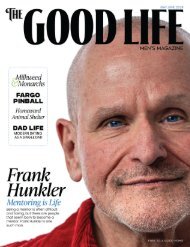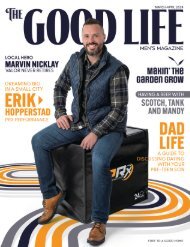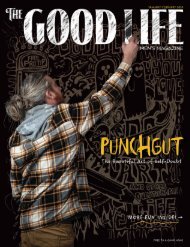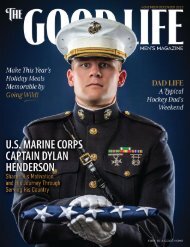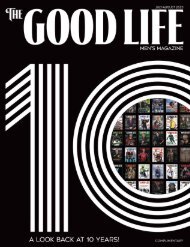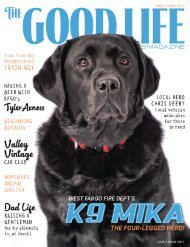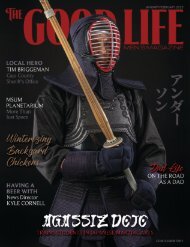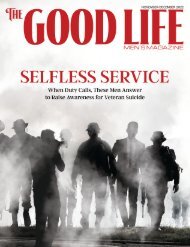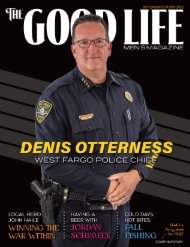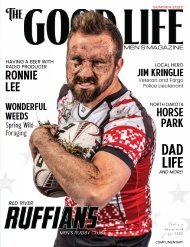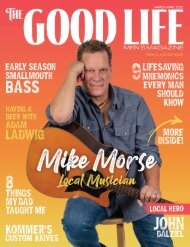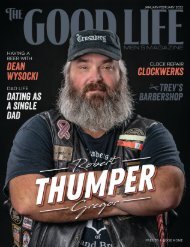The Good Life – March-April 2015
Fargo Moorhead's Only Men's Magazine - Featuring Chris Berg, Local Heroes - American Red Cross, Having a Beer with Lt. Joel Vettel, Car Clubs and More!
Fargo Moorhead's Only Men's Magazine - Featuring Chris Berg, Local Heroes - American Red Cross, Having a Beer with Lt. Joel Vettel, Car Clubs and More!
Create successful ePaper yourself
Turn your PDF publications into a flip-book with our unique Google optimized e-Paper software.
3
How to Respond When You Can’t Re<br />
“Hi, (insert your name here)! Man, it’s been ages. How are you?”<br />
This sounds like the beginning of a nice, cordial conversation. It might not last<br />
for longer than two minutes. <strong>The</strong>n again, it may last a half hour. It’s great seeing<br />
them again. It would be especially enjoyable if you could remember their name.<br />
When you are faced with someone who knows you, but you can’t remember<br />
anything about them, or you recognize them but can’t remember their name,<br />
you have a few routes to choose from.<br />
<strong>The</strong> jerk<br />
If you want to come off as a horrible person, “the jerk” is always an option.<br />
After their exuberant greeting, act offended that they are daring to address<br />
you (I immediately imagined Kanye West taking this option). Follow that<br />
reaction with this statement: “I don’t even know who you are, ya creep. Why<br />
are you talking to me? Do I have food on my face, or something?”<br />
I can predict with some certainty that they will cease conversing and walk<br />
away, one eyebrow raised or both furrowed, in wonderment as to what just<br />
happened. You will never hear from them again, not that you knew who<br />
they were, anyway. A grapevine effect may take place where acquaintances<br />
hear about your act and begin despising you from afar. You will then<br />
become a modern-day Ebenezer Scrooge and eat cold porridge by yourself<br />
at night without even a dog to comfort you in your misery <strong>–</strong> you, the jerk.<br />
2<br />
Vaguely there<br />
Unfortunately, this is the route I usually take. <strong>The</strong>ir cheerful hello is<br />
greeted by an equally ecstatic response from me. I then ask roundabout<br />
questions in hopes they will produce character clues. In these instances,<br />
I’ve oftentimes said, “It’s been forever. When was the last time we<br />
ran into each other?” If I just met them last week, things could get<br />
incredibly awkward.
Methods of<br />
Recovery<br />
BY: MEGHAN FEIR<br />
member Someone’s Name<br />
When I recognize their face but not their<br />
name or history, I continue talking with them<br />
until something jogs my memory. But when<br />
the conversation is over and the questions<br />
still remain, it nags me for days. Be aware<br />
that this is the method of potential mental<br />
torture.<br />
Honesty is the best policy<br />
This is probably the most brave and<br />
commendable way to figure out who the<br />
mystery speaker is and why you know them.<br />
If you go with the honest approach, it has<br />
the potential to come off as harsh and could<br />
embarrass the other person, so be gentle.<br />
By kindly stating, “I’m sorry, but I just can’t<br />
place your name right now,” you’ll appear<br />
bold, confident, considerate and forgetful.<br />
However, it is better to be a flake than a jerk<br />
or bad actor.<br />
<strong>The</strong> forgotten one<br />
When you are the one whose name and<br />
identity has been forgotten, misplaced in a<br />
sea of faces more recognizable than your own,<br />
don’t take it personally. Graciously remind<br />
them how you know each other and cut the<br />
conversation short. After all, you have other<br />
places to be and people to meet, people who<br />
may or may not remember your name when<br />
you see them out of context in the grocery<br />
store.<br />
3
contents<br />
MARCH-APRIL <strong>2015</strong><br />
VOLUME 2 • ISSUE 5<br />
ON THE COVER<br />
18 CHRIS BERG - STAY CLASSY FARGO!<br />
From Playing Football to Broadcasting:<br />
Berg, TV Host, Salesman, Father,<br />
Shares His Point of View<br />
10<br />
06<br />
in every issue<br />
16 HAVING A BEER WITH ...<br />
Fargo Police Lieutenant - Joel Vettel<br />
18<br />
28 FATHERS<br />
12 Tips on Raising Boys<br />
30 LOCAL HEROES<br />
AMERICAN RED CROSS - <strong>The</strong> Power of<br />
Volunteers Bearing Help and <strong>Good</strong>will<br />
CONTENTS<br />
02 METHODS OF RECOVERY<br />
How to Respond When You Can’t<br />
Remember Someone’s Name<br />
06 MASTER OF THE STRINGS<br />
How One Luthier is Keeping Music Alive<br />
in the F-M Area<br />
<strong>The</strong> <strong>Good</strong> <strong>Life</strong> Men’s Magazine is distributed six<br />
times a year by Urban Toad Media LLP. Material<br />
may not be reproduced without permission. <strong>The</strong><br />
<strong>Good</strong> <strong>Life</strong> Men’s Magazine accepts no liability for<br />
reader dissatisfaction arising from content in this<br />
publication. <strong>The</strong> opinions expressed, or advice given,<br />
are the views of individual writers or advertisers and<br />
4do not necessarily represent the views or policies of<br />
<strong>The</strong> <strong>Good</strong> <strong>Life</strong> Men’s Magazine.<br />
CREATIVE DIRECTOR<br />
Dawn Siewert<br />
dawn@urbantoadmedia.com<br />
PHOTOGRAPHY<br />
Darren Losee<br />
darren@urbantoadmedia.com<br />
PUBLISHED BY<br />
Urban Toad Media LLP<br />
www.urbantoadmedia.com<br />
READ AN ISSUE ONLINE: issuu.com/thegoodlifemensmag<br />
ADVERTISING INQUIRIES<br />
dawn@urbantoadmedia.com | 701-388-4506<br />
darren@urbantoadmedia.com | 701-261-9139
24<br />
12<br />
16<br />
CONTENTS CONTINUED<br />
10 MIDWEST MUSCLE<br />
New Gym Offers Unique Atmosphere<br />
and Equipment<br />
12 CAR CLUBS SPOTLIGHT<br />
<strong>The</strong> <strong>Good</strong> <strong>Life</strong> Interviews Three Local<br />
Car Clubs That Do More Than Just<br />
Fix Up Old Cars<br />
24 THE MAN WITH THE BANDS<br />
Pat Lenertz is One of the Busiest<br />
Musicians in Fargo-Moorhead<br />
30<br />
CONTRIBUTING WRITERS<br />
Soo Asheim<br />
Jessica Ballou<br />
Meghan Feir<br />
Paul Hankel<br />
Jessica Jasperson<br />
Alisha Underlee Nelson<br />
FOLLOW URBAN TOAD MEDIA ON TWITTER & FACEBOOK
How One Luthier is Keeping Music Alive<br />
in the F-M Area<br />
BY: MEGHAN FEIR | PHOTOS: URBAN TOAD MEDIA<br />
6<br />
Despite its convenient and bustling location on Main Avenue in Downtown<br />
Fargo, Christian Eggert Violins is a humble shop that will never be heard<br />
screaming for attention. You may not have been aware of its existence,<br />
unless you have besought the aid of one of the shop’s skilled luthiers to fix the<br />
broken neck on your cello.<br />
One could argue that the mustachioed, spectacle-wearing<br />
Glenn Miiller (double N, double I, double L) specializes in<br />
more than the repairing of stringed instruments. He possesses<br />
a formidable track record of gluing together the broken hearts<br />
of orchestra students whose dreams were once dashed by<br />
the near ruination of their prized instruments.
“<br />
When a student<br />
comes in here<br />
and thinks it’s the<br />
end of the world,<br />
I love being able<br />
to identify the<br />
problem and fix<br />
it,” Miiller said.<br />
For the craftsman, the best part<br />
of his job is “being able to help<br />
someone with what they’re trying<br />
to accomplish. If I can make a small<br />
change to their instrument that<br />
makes it easier and more enjoyable<br />
to play, I feel like I’ve done my job.”<br />
Miiller’s adoration for repairing<br />
broken objects began in his teens<br />
after purchasing a worn-out guitar.<br />
“I had this really crappy guitar<br />
and started to think, ‘How can I<br />
make this thing work better?’ <strong>The</strong>n<br />
I got an electric guitar and tried to<br />
customize it to make it more my<br />
own and suit my needs.”<br />
Playing his own tune<br />
Originally from Hazen, N.D.,<br />
Miiller attended Bismarck State<br />
College until the realization hit him<br />
that he was going to college due to<br />
societal expectations, not because<br />
he was passionate about a particular<br />
major offered. “It wasn’t for me,”<br />
Miiller said.<br />
In remembering a suggestion<br />
made by one of his high school<br />
counselors, Miiller researched<br />
the instrument repair programs<br />
at Southeast Technical College in<br />
Redwing, Minn. He packed up his<br />
bags and made the 8-hour drive<br />
to southern Minnesota where<br />
he learned the craft of repairing<br />
guitars, violins and other stringed<br />
instruments.<br />
7
After two years of working in Milwaukee, Wis., full time at<br />
a music repair shop, Miiller wanted to be closer in proximity<br />
to his roots. With $1,200 in his figurative pocket, no place to<br />
stay and not a job in sight, he “up and moved to Fargo.”<br />
Not long after his relocation, Christian Eggert Violins<br />
opened the shop in Fargo, and Miiller found himself in his<br />
niche.<br />
Relishing his craft<br />
Ten years and countless repaired instruments later, Miiller<br />
is still finding gratification in his craft. Music from Classical<br />
Minnesota Public Radio appropriately serenades the shop as<br />
he works. Knives of all shapes and sizes are strewn over his<br />
working space, and a blowtorch rests on a desk awaiting its<br />
next use.<br />
<strong>The</strong>re is organized chaos all around this quaint hospital<br />
for battered violas, violins, cellos and the like, and Miiller<br />
wouldn’t have it any other way.<br />
“<strong>The</strong> good life to me is having a fulfilling day at work and<br />
feeling like I’ve really helped people,” Miiller said. “When<br />
somebody brings in their instrument in tears, they come back<br />
in a week and get their instrument again <strong>–</strong> that’s the most<br />
fulfilling thing for me.”<br />
Christian Eggert Violins is open weekdays from 9:30 a.m.<br />
to 5:30 p.m. and Saturdays from 9:30 a.m. to 2 p.m. and is<br />
located at 618 Main Avenue in Fargo, N.D. More information<br />
can be found on their website, christianeggertviolins.com, or<br />
by calling 701-280-7017.
Ask the expert<br />
How do you choose the right<br />
instrument?<br />
“If you want the very best<br />
instrument, you need to play as<br />
many as you can and find the one<br />
you like the best.<br />
Instruments are like ice cream;<br />
do you like mint chocolate chip or<br />
rocky road? When you play in an<br />
orchestra, your instrument is your<br />
voice, and you should really like<br />
the sound of your voice. Our voices<br />
are all different. That’s what makes<br />
them great.<br />
You can take one instrument<br />
made by a maker next to another<br />
made by that same maker, and they<br />
may be slightly different because<br />
wood is not consistent.<br />
When violinmakers make an<br />
instrument, they sometimes use a<br />
different pattern. It could be shaped<br />
slightly different. <strong>The</strong>y’ll have an<br />
idea in mind of what they want to<br />
accomplish, like making it bright<br />
and powerful or warm and intimate.<br />
You just really have to try as<br />
many instruments as you can and<br />
find the one you enjoy the best.”<br />
Should you sell your child’s<br />
instrument when it’s been<br />
gathering some dust?<br />
“Keep it. Put it in the closet.<br />
Stash it away and forget about it<br />
because eventually, in about 15 or<br />
so years, your kid is going to say,<br />
‘Hey, mom and dad, where’s that<br />
violin? I want to play that thing<br />
again.’<br />
You go through these phases in<br />
your life where you’re really busy<br />
playing music in high school, then<br />
you go off to college and you’re busy,<br />
and then you’re busy becoming an<br />
adult and building a career.<br />
Finally, when you get settled<br />
down, you think, ‘Gosh, I had so<br />
much fun playing that instrument.<br />
I want to try it again.’ Look at me; I<br />
went back to the baritone after 16<br />
years.<br />
It doesn’t matter if you’re great.<br />
You just have to enjoy it. That’s the<br />
most important part.”<br />
Facts:<br />
• Glenn Miiller was not a popular big<br />
band leader in the 1940s. Glenn Miller<br />
was.<br />
• <strong>The</strong> most expensive instrument Miiller<br />
has worked on was an Italian cello<br />
appraised around $175,000.<br />
• After crossing the Atlantic from Germany<br />
to America, Miiller’s great-grandfather<br />
wanted to keep the appearance of umlauts<br />
on their last name, so he changed the U to<br />
two I’s. When you write Miiller in cursive, a<br />
U with two dots on the top looks the same<br />
as two lowercase I’s.<br />
• Miiller played the trumpet and baritone<br />
in high school and recently picked up the<br />
baritone again after a 16-year hiatus. He<br />
even played in Tuba Christmas at the West<br />
Acres Shopping Center this past December.<br />
• He plays the mandolin.<br />
• When forced to pick a favorite composer<br />
and piece, Miiller chose Antonio Vivaldi’s<br />
Mandolin Concerto in C Major.<br />
• He loves fixing motorcycles (and<br />
everything else). A ’77 Honda CB550, a<br />
BMW and a Gold Wing can be found in his<br />
garage, unless he’s driving one of them.<br />
9
BY: JESSICA JASPERSON | PHOTOS: URBAN TOAD MEDIA<br />
est Fargo natives, Ty Zaczkowski and<br />
Jacob Kinsella, noticed a need in the<br />
Fargo-Moorhead area for a gym with<br />
extensive equipment and a welcoming atmosphere for<br />
bodybuilders and the like. Zaczkowski and Kinsella<br />
filled this need with their gym, Midwest Muscle, located<br />
in Fargo.<br />
For one year the idea of opening a gym that welcomes<br />
everyone stirred in Zaczkowski’s and Kinsella’s minds<br />
after a gym frequented by bodybuilders and competitors<br />
closed. Forced to workout at other gyms in<br />
the area, both dreamed of the day a gym<br />
would fit their workout needs and the<br />
needs of others.<br />
After deciding to open a gym,<br />
Zaczkowski and Kinsella spent the<br />
following year searching the Internet<br />
for auctions and individuals interested<br />
in selling unwanted equipment. While<br />
still working full-time the team of two<br />
travelled almost every two weeks during<br />
the weekend to pick up their latest finds<br />
for the gym.<br />
“We have a lot of unique equipment,<br />
and it’ll give people who take lifting<br />
seriously an edge over everyone else,”<br />
10<br />
“<br />
We have a lot of<br />
unique equipment,<br />
and it’ll give<br />
people who take<br />
lifting seriously<br />
an edge over<br />
everyone else,”<br />
— Zaczkowski<br />
Zaczkowski said. “It is really important to target certain<br />
muscles, and you need the right equipment to do so.”<br />
While travelling across the tri-state area to pick up<br />
various commercial grade equipment, Zaczkowski and<br />
Kinsella viewed an array of different gyms. <strong>The</strong>y saw<br />
firsthand gym qualities that work and do not work.<br />
<strong>The</strong>y used this advantage to create a gym that welcomes<br />
everyone no matter what fitness level or interest.<br />
Midwest Muscle provides four separate<br />
spaces to work out, locker rooms, and<br />
cubbies for those who don’t wish to use<br />
the locker rooms. What’s unlike many<br />
other gyms is the amount of free weights<br />
made available for customers to use.<br />
In addition to free weights, there is<br />
plenty of cardio equipment and multiple<br />
machines that help target different areas<br />
of the body. Zaczkowski estimates the gym<br />
holds at least 30 pieces of equipment. Lastly,<br />
one of the spaces provides wrestling mats<br />
and punching bags for those interested in<br />
mixed martial arts (MMA) or kickboxing.<br />
“I really like the idea of this area being<br />
matted and having bags,” Kinsella said.
“Because nowadays MMA is really popular, but really<br />
expensive. People can’t afford a lot of facilities in the F-M<br />
area. This will give them a space to work out and roll<br />
around in.”<br />
As Midwest Muscle grows, Zaczkowski and Kinsella<br />
share the same goal for the gym: to keep changing.<br />
Whether this means putting in better equipment or<br />
offering different services they want a gym that offers the<br />
best of the best for the F-M area.<br />
“My goal of this place is to have a unique atmosphere<br />
and have a really good community of people that go,”<br />
Kinsella said. “<strong>The</strong> people who are serious about lifting<br />
form a community. We want people to feel comfortable<br />
coming here every single day.”<br />
“We also don’t want people to be scared either,”<br />
Zaczkowski said. “Come check it out. <strong>The</strong> goal was to<br />
have something for everybody.”<br />
In the future Midwest Muscle hopes to give back<br />
to the community by sponsoring athletes, teams, local<br />
university clubs, and bodybuilding and physique<br />
competitors.<br />
“It’s only going to get better, and we want it to get<br />
to the point that if you want it, we’ll get it,” Zaczkowski<br />
said. “We’re going to be able to.”<br />
11
THE GOOD LIFE INTERVIEWS THREE LOCAL CLUBS<br />
THAT DO MORE THAN JUST FIX UP OLD CARS<br />
BY: PAUL HANKEL | PHOTOS: URBAN TOAD MEDIA<br />
No one is going to tell you it’s easy to be a car club in North Dakota. <strong>The</strong> long winters and relatively short summer<br />
months make it tough to get out and show off a polished custom hot rod, much less go for club cruises.<br />
And yet, the car club scene continues to grow, locally and regionally. It all comes down to a genuine passion for<br />
classic cars and for being involved in one’s community.<br />
<strong>The</strong> <strong>Good</strong> <strong>Life</strong> met up with three of the area’s clubs to find out who they are, what events they participate in, and<br />
what activities the club’s participate in outside of fixing up hot rods.<br />
12
TOPPERS CAR CLUB<br />
founded: 1953<br />
membership: 17 members<br />
Toppers, now famous for their monthly Cruise<br />
Nights held during the summer months, has one main<br />
goal, according to current club President Rich Barnes: to<br />
give back to the community.<br />
In their 67th year, Toppers continues to grow as well<br />
as provide needed charity work to local and regional<br />
groups and organizations. <strong>The</strong>y do this by fundraising<br />
and hosting large local events each year.<br />
Last year, Toppers participated in the Service Dogs of<br />
America program, which provides trained dogs to veterans<br />
who are suffering from post traumatic stress disorder.<br />
<strong>The</strong> club also donated four medical defibrillators to a<br />
veteran’s home in Lisbon, North Dakota, and hosted a<br />
Christmas party for the local Boys and Girls Club.<br />
Toppers Car Club also hosts a yearly car show at the<br />
West Fargo Veterans Memorial Building. <strong>The</strong> show has<br />
been taking place for over 50 years, and is considered<br />
one of the premier car shows in this region.<br />
13
SWANKS CAR CLUB<br />
founded: originally in 1956,<br />
refounded in 2007<br />
membership: 20 members<br />
According to former club president Gary Johnson, the<br />
current Swanks Car Club was refounded with the notion<br />
of sharing ideas and passions about hot rods. While<br />
the club was originally formed in 1956, it was more of<br />
a social group than a car club. As membership grew, the<br />
transition to a fully fledged car club took place. As time<br />
passed, members moved on and the club was dormant for<br />
several years.<br />
Swanks was revived by Steve Olson, many years later,<br />
and now features hot rods from as early as the 1920’s,<br />
through the 1950’s and 1960’s.<br />
Swanks Car Club hosts a yearly show in Casselton,<br />
North Dakota, where the club is mainly located. <strong>The</strong> show<br />
takes place during Cass County Summer Fest and features<br />
as many as 400 cars.<br />
As well as donating to several local charities, Swanks<br />
also has a club scholarship that provides financial backing<br />
to a local student who is going into the automotive field.<br />
14
SUEDES CAR CLUB<br />
founded: 2004<br />
membership: 20 members<br />
While most members are Fargoans, Suedes Car Club has members as far away as Colorado, Illinois, and Nebraska.<br />
<strong>The</strong> club’s slogan is, “the future of hot rodding is history,” and this is evidenced by the bevy of club hot rods and<br />
muscle cars that are pre-1965 models. <strong>The</strong> oldest club car, according to club member Stefan Robinson, is a 1932 Ford<br />
Coupe.<br />
<strong>The</strong> club’s activities include hosting the Suedes Car Club swap meet, which takes place twice during the summer,<br />
as well as attending local and regional car shows.<br />
15
BY: PAUL HANKEL | PHOTO: URBAN TOAD MEDIA<br />
An 18-year law enforcement veteran, Lt. Joel Vettel sat down with <strong>The</strong> <strong>Good</strong> <strong>Life</strong><br />
at Drekker Brewing Company to discuss his life, career and connection to the<br />
community.<br />
Born in 1971, in Moorhead,<br />
Minnesota, Lieutenant Joel Vettel of<br />
the Fargo Police Department is the<br />
second youngest of seven children<br />
and grew up on a farm ten minutes<br />
outside of Hillsboro, North Dakota.<br />
Vettel attended Hillsboro High<br />
School, where he excelled at wrestling<br />
and distance running. “We weren’t a<br />
family of means,” says Vettel, “My<br />
opportunities to go to college were<br />
to work hard, wrestle, and earn a<br />
scholarship. “<br />
Vettel lived by these three<br />
principles and was able to earn a<br />
scholarship to wrestle collegiately at<br />
North Dakota State University, where<br />
he was a three-time All American.<br />
16<br />
“Coming from a large family, you<br />
learn what it means to work hard and<br />
to sacrifice. I think that’s a good life<br />
lesson.”<br />
While at NDSU, he majored<br />
in Sociology and Minored in<br />
Business Administration. Following<br />
graduation, Vettel moved to the<br />
Twin Cities area and went to work<br />
for Target Corporation. His duties<br />
included Loss Prevention and Special<br />
Projects. Currently, he is married and<br />
lives with his wife and two daughters<br />
in Fargo.<br />
Vettel decided to return to Fargo<br />
and join the Fargo Police Department<br />
(FPD) in 1997, while pursing his<br />
Master’s Degree. He served as a<br />
patrolman for the first 13 years of his<br />
career. Currently, he is the Lieutenant<br />
in Charge of Investigations and also<br />
the Public Information Officer. His<br />
duties include overseeing current<br />
investigations and acting as a liaison<br />
between the FPD and the community.<br />
<strong>The</strong> <strong>Good</strong> <strong>Life</strong> (GL): What are the<br />
best aspects of your job?<br />
Lt. Joel Vettel (JV): Working<br />
with some of the best police law<br />
enforcement officers in the country.<br />
I also really enjoy working with the<br />
public and getting to know and work<br />
with the people in the community<br />
that I talk to everyday.
GL: You’re also busy off the clock. Tell us about that.<br />
JV: I don’t hunt and I don’t fish, those just aren’t my<br />
hobbies. My hobbies include being involved on boards<br />
and in community projects. Also, my wife, Sandy, and my<br />
two daughters are the most important thing in my life.<br />
Vettel continues to serve on several local boards<br />
including the Board of Trustees for the United Way and<br />
a three-term stint on the Fargo Park Board. Vettel is also<br />
heavily involved in the NDSU Athletic Department and<br />
also helps coordinate the Junior National Wrestling<br />
Tournament that takes place, yearly, at the Fargodome.<br />
Vettel also twice-served as the liaison between the FPD and<br />
ESPN Gameday, when the show took place in downtown<br />
Fargo.<br />
In his spare time, Vettel participates in several athletic<br />
competitions including Adventure Races, Tough Mudders,<br />
and Ultra Races.<br />
GL: What are some of the cool types of training that you’ve<br />
gotten to do?<br />
JV: I’ve had the opportunity to be heavily involved in the<br />
area of defensive tactics. I was an instructor in that area<br />
and got hundreds of hours of training in that area.<br />
Vettel has taught a multitude of defensive tactics<br />
classes, including Taser instruction and hand to hand<br />
combat techniques. He even completed United States<br />
Secret Service Protective Detail Training.<br />
JV: We have a relatively low crime rate, a high quality<br />
of life and it’s not like that everywhere. Also, we serve a<br />
community that cares. People don’t move here for the<br />
weather, they move here for the quality of life that exists<br />
here.<br />
If one word could be used to describe the life of<br />
Lieutenant Vettel, that word would have to be ‘constant’.<br />
Case in point: during the interview, Vettel fielded phone<br />
calls ranging from an interview request to the results of<br />
a search warrant. You know…everyday stuff.<br />
This author will be the first to admit: he tends to<br />
dramatize the busyness of his schedule. However, let’s<br />
be real for a second: Lieutenant Vettel doesn’t have<br />
to. He runs the Investigative unit of the Fargo Police<br />
Department, a unit that solves high-profile crimes at<br />
a rate that’s higher than the national average. This is<br />
all while also serving as the FPD’s Public Information<br />
Officer, being on a laundry list of community boards, a<br />
public speaker, and being married with two daughters.<br />
Somehow, Vettel also finds time to run athletic races,<br />
such as 30-mile long obstacle courses…for fun. So, the<br />
next time you’re tempted to roll over at 7 a.m. and hit<br />
the snooze button, just remember — Lieutenant Vettel<br />
has probably been up for a few hours already, making<br />
this city better than it was the day before. And if that<br />
isn’t the definition of living “<strong>The</strong> good life,” then this<br />
writer doesn’t know what is.<br />
GL: Did you ever want to be on the Red River Swat Team?<br />
JV: I think it’s something that is a very cool opportunity.<br />
For me, I had other opportunities and in, as far as a work/<br />
life balance, it just wasn’t an option for me.<br />
GL: Do you watch police dramas?<br />
JV: (laughs) Usually, the only times I do, it’s with my<br />
daughters, It’s kinda funny, but I’m probably the only<br />
guy where, I’ll be upstairs watching some sitcom, while<br />
my wife and daughters are downstairs watching ESPN!<br />
<strong>The</strong>y’re the real sports nuts.<br />
GL: Be honest, are the FPD police cruisers designed to<br />
look cool, as well as be functional interdiction vehicles?<br />
JV: I hope so! We want people to take notice of us.<br />
Presence is a huge focus for us. Sometimes it’s better to<br />
be seen than be heard. It’s a deterrent. Sometimes it’s all<br />
about just being there.<br />
GL: What’s unique about being a police officer in Fargo?<br />
17
“<br />
With POV, I’m looking to hold<br />
you accountable, to debate the<br />
issues, so it’s always fun to spar<br />
with people and go through some<br />
of those mental gymnastics.<br />
— Chris Berg<br />
”<br />
18
BY: JESSICA BALLOU | PHOTOS: URBAN TOAD MEDIA<br />
From Playing Football<br />
to Broadcasting: Berg,<br />
TV Host, Salesman, Father,<br />
Shares His Point of View<br />
o say Chris Berg is a busy man would be an understatement.<br />
As a host of two programs on Valley News Live and<br />
a salesman, Berg’s days are packed full of prepping,<br />
interviewing, marketing companies, spending time with<br />
his family and more.<br />
He’s typically in the studio by 8 a.m. to prep for<br />
North Dakota Today. Once that show is done at 10<br />
a.m., he works on some sales and preps for his<br />
hosting gig on 6:30 Point of View.<br />
‘AN ACT OF GOD’<br />
Berg said he was originally interested in<br />
broadcasting to make a difference, which is<br />
why he’s still passionate about it.<br />
“I think there’s a real opportunity to make a<br />
difference in our community,” he said.“You’ve got a<br />
chance where you can help people if there’s something<br />
going on, there’s an injustice happening or something’s<br />
not right for a certain person or group of people, whatever<br />
it might be, there’s obviously a chance to move the public<br />
opinion needle and make an impact.”<br />
He also said it was an act of God that got him involved<br />
in the broadcasting world in Fargo.<br />
“If you would have said to me five years ago, Chris,<br />
you’re going to be hosting a lifestyle show and an issues<br />
show, I would’ve thought you were on some pretty serious<br />
drugs,” he said with a laugh. “<strong>The</strong> door opened for me to<br />
come back to North Dakota five years ago, and the door<br />
opened for me to do some radio outside of what I was<br />
coming back here to do initially. And then God opened a<br />
door for me to do a three-hour radio show in 2010. And then<br />
from there, something happened with the radio station and<br />
then God opened a door for me to get on TV.”<br />
19
“<br />
“If you would<br />
have said to me<br />
five years ago,<br />
Chris, you’re going<br />
to be hosting a<br />
lifestyle show and<br />
an issues show, I<br />
would’ve thought<br />
you were on some<br />
pretty serious<br />
drugs,” he said<br />
with a laugh.<br />
He used to work for and travel with motivational speaker and life coach<br />
Tony Robbins, whose message was all about being bold, having a vision and<br />
making it happen.<br />
“What’s been amazing about my journey back to North Dakota is that I<br />
can’t say I came back and I made it happen to have a radio show,” he said. “I<br />
didn’t make it happen to be on two TV shows. <strong>The</strong> more I’ve kind of let go and<br />
let God lead my life, the more doors He’s opened at really the perfect time, so<br />
it’s just been because of Him that I’m doing television.”<br />
He said one of the greatest things he learned from Robbins was how to<br />
communicate effectively, which definitely comes in handy for his two shows.<br />
“So for example with Point of View, it’s not a scripted show,” he said. “It’s<br />
not a news cast where I’m going to say X and then we’re going to this package<br />
and I’m going to come back and say Y or Z. So I think it’s really helped me be<br />
able to get in front of a camera for 30 minutes and dance in the conversation<br />
and be able to speak effectively and make my point.”<br />
“With POV, I’m looking to hold you accountable, to debate the issues, so<br />
it’s always fun to spar with people and go through some of those mental<br />
gymnastics,” he added.<br />
20<br />
‘I REALLY LOVE WHAT I’M DOING’<br />
Berg used to split time with KFGO Radio’s Joel Heitkamp as moderator of<br />
a Hot Box segment before hosting it himself. Berg started hosting 6:30 Point<br />
of View solo in <strong>April</strong> 2013.<br />
Once the radio show switched to new management, Berg said he felt like<br />
it was time for him to try something different, so when Wareham offered
him the chance to take over Point of View and be a co-host on a new hour-long<br />
lifestyle show that developed into North Dakota Today, he jumped at the chance.<br />
Around this same time, a woman who was in sales left to get a job in Bismarck<br />
so Berg took over her accounts and started doing sales as well.<br />
Berg said Point of View is the only interactive television show in the Red River<br />
Valley, so it’s unique in that he and the other people on the show try to integrate<br />
people’s feedback as much as possible. He views it as an opinionated issues show<br />
that strives to focus not just on politics.<br />
“We actually don’t want it to be politically focused,” he said. “I really see it<br />
more as these are the issues the people in our community are talking about, and<br />
there’s also some controversy around them.”<br />
He said having social media integrated into POV has been great because there<br />
are so many points of view out there that perhaps he hadn’t thought of before,<br />
so it spurs great discussions. He also said hosting Point of View is full of great<br />
challenges, like trying to stay on top of the news and always being ready and<br />
“on.”<br />
“<strong>The</strong> biggest challenge about POV is trying to make it fresh, creative, fun and<br />
edu-taining every single night,” he said.<br />
“I can’t call the Today Show and ask them to move back Matt Lauer for 15<br />
minutes because I’m not really feeling it at 9 o’clock,” he added. “That’s one of<br />
the most interesting aspects for me is that no matter what’s going on in my life,<br />
no matter what’s happening, at 9 a.m. and 6:30 p.m., I gotta be ready to roll<br />
because that red light is about to hit and there’s nothing I can do about it.”<br />
Berg said his attitude is inspired by John Wooden, who coached<br />
basketball at the University of California, Los Angeles, and won 10 NCAA<br />
“<br />
“I didn’t make it<br />
happen to be on<br />
two TV shows. <strong>The</strong><br />
more I’ve kind of<br />
let go and let God<br />
lead my life, the<br />
more doors He’s<br />
opened at really<br />
the perfect time,<br />
so it’s just been<br />
because of Him<br />
that I’m doing<br />
television.”<br />
21
national championships in a 12-year period, which<br />
was unprecedented. He said Wooden’s philosophy<br />
focused not on showing up every day and looking at<br />
the scoreboard, but showing up and getting one percent<br />
better every day because if you do that over the course of<br />
a year, the growth you go through is unbelievable.<br />
“So that’s where I’m at. I really love what I’m doing.<br />
I like being able to swing public opinion, make a<br />
difference in our community, and if I can get one percent<br />
better at doing that every single day, then God will put<br />
me where I’m supposed to be,” he said.<br />
He then added how grateful he is to do what he does,<br />
and he appreciates and respects the responsibility of<br />
being able to have a platform to share issues and affect<br />
change.<br />
PLAYING FOOTBALL AND SETTING GOALS<br />
Berg was born in raised in Fargo. His parents got<br />
divorced when he was eight or nine years old, and then<br />
he started playing football in sixth grade. Berg said he<br />
started playing quarterback in eighth grade, and he<br />
never lost a football game as a quarterback until college.<br />
He loved watching John Elway, and he decided that he<br />
wanted to play quarterback at Stanford, which later came<br />
true.<br />
His dad started giving him goal-setting and positive<br />
mental attitude books when Berg was in high school,<br />
PHOTOS SUBMITTED BY: CHRIS BERG<br />
22
so he said he developed an affinity for those subjects.<br />
His mom moved to Colorado, so it was just Berg and<br />
his father. He had to grow up fast, which he said was<br />
good for him. He got a football scholarship to Stanford<br />
University in California, and his freshman year coach<br />
was Dennis Green, who went on to coach the Minnesota<br />
Vikings.<br />
In his spare time Berg said all he wants to do is be<br />
with his family. He said he’s been working such long<br />
hours that every free moment he has, he wants to go<br />
home and be with his wife and five-year-old daughter.<br />
“That’s such a great age, and I know in a few years,<br />
I’m going to be the last person she’s gonna want to hang<br />
out with, so I’m just trying to take advantage of that as<br />
much as I can right now,” he said.<br />
When asked what the good life means to him, Berg<br />
responded:<br />
“<br />
<strong>The</strong> good life means to me being able<br />
to live your life passionately, doing what<br />
you want to do with passion, making a<br />
difference in people’s lives and doing<br />
the right thing.” — Chris Berg<br />
23
BY: ALICIA UNDERLEE NELSON | PHOTOS: URBAN TOAD MEDIA<br />
M<br />
usic is in Pat Lenertz’s blood. From humming along with<br />
the oldies station in his parents’ car to singing in choirs<br />
from elementary school until well into college, Lenertz<br />
has always been musical. But it was the gift of an acoustic<br />
guitar when he was fifteen that really set his course. “I finally had<br />
an instrument I could focus my energies with and a medium for<br />
songwriting,” Lenertz said.<br />
He played his first gig at <strong>The</strong> Funky Monkey (a now defunct<br />
coffee shop across from Fargo <strong>The</strong>atre) with the band Bad Mojo<br />
just a few months later. His expressive voice, which runs the gamut<br />
from a warble to a growl, his guitar skills and the achingly honest,<br />
melodic way he writes and interprets Americana and roots music<br />
have made him a fixture in the Fargo-Moorhead music scene ever<br />
since.<br />
Lenertz has performed with multiple bands since his 1999<br />
debut, including the aforementioned Bad Mojo, <strong>The</strong> Legionnaires,<br />
<strong>The</strong> Quarterly, Heavy is the Head and his eponymous quartet,<br />
the Pat Lenertz Band. Reggae roots band Heavy is the Head, <strong>The</strong><br />
Quarterly and the Pat Lenertz Band are all still performing, so for<br />
the last several months, Lenertz has balanced playing in multiple<br />
bands and earning a master’s degree in social work.<br />
“I am a plate spinner,” Lenertz said. “I multitask and try to stay<br />
afloat.” Whatever he’s doing, he’s doing something right. He’s an<br />
24
audience favorite and one of the busiest performers in<br />
the region.<br />
“I was very honored to have received the ‘Best<br />
Musician’ award from the High Plains reader last year,”<br />
he said. “But I am proud when a few people come to<br />
our shows and dance and have fun. That makes me<br />
very happy.”<br />
In between gigs and school, he also found time<br />
to record a buzzed-about concept album with the Pat<br />
Lenertz Band. <strong>The</strong> project captures the energy and<br />
camaraderie that Lenertz loves and transforms it into a<br />
new experience for listeners.<br />
<strong>The</strong> album, titled “Love, Loss & Regret”, features<br />
fourteen of Lenertz’s original songs and three<br />
original vignettes narrated by Pat’s close friend Kevin<br />
Hendrickson and was recorded over the course of a<br />
year. It explores the evolution of moods and feelings<br />
over time through artfully layered arrangements<br />
and Lenertz’s brand of emotional storytelling. <strong>The</strong><br />
songs explore falling in love, losing friends and<br />
other emotional touchstones that will resonate with<br />
audiences.<br />
“<strong>The</strong> songs stand alone by themselves, but it is the<br />
full album that tells the story,” said Lenertz. “I wanted<br />
to create an aural story for myself and listeners. I<br />
wanted to weave a meta-narrative with the individual<br />
songs through placement and flow.”<br />
<strong>The</strong> project also gave Lenertz a chance to connect<br />
with artists he respected. He brought over 25 local<br />
musicians into the studio as guest artists. It also<br />
gave him a chance to reconnect with Ken Davis, his<br />
friend and former band mate in <strong>The</strong> Legionnaires.<br />
Davis engineered and produced the record, which was<br />
recorded in Davis’ Positively Tenth Street Studio.<br />
This type of collaboration isn’t unusual in the<br />
downtown music scene. And it’s a big part of why<br />
Lenertz continues to support and perform in this part<br />
of the city.<br />
“I love to play downtown,” he said. “And I wouldn’t be<br />
anything without the wonderfully talented musicians that<br />
I am lucky enough to play with. We are lucky to be living<br />
in an area with such a diverse blend of wonderful music.<br />
<strong>The</strong>re is a constant ebb and flow of number and types<br />
“We are lucky to be living in<br />
an area with such a diverse<br />
blend of wonderful music.<br />
<strong>The</strong>re is a constant ebb and<br />
flow of number and types of<br />
bands that play around<br />
here, from heavy music<br />
to acoustic.”<br />
25
of bands that play around here, from heavy music to<br />
acoustic.”<br />
His favorite venues include bustling bars like<br />
Sidestreet Grille & Pub, and Dempsey’s, the upscale<br />
but laid-back HoDo Lounge, the come-as-you-are<br />
downtown VFW and downtown’s live music mainstay,<br />
<strong>The</strong> Aquarium. He also loves playing outdoors in the<br />
parks during those warm prairie nights.<br />
<strong>The</strong>re’s a new Pat Lenertz Band album in the works<br />
for <strong>2015</strong>, which means Lenertz is spending more of<br />
his time writing, a process he’s refined and polished<br />
during his years in the business. Part of the proficiency<br />
comes from experience. But Lenertz also understands<br />
and respects the nuances of his creative process.<br />
“It’s always been a feeling for me,” he said. “I<br />
call it the ‘switch’. It’s the muse, or the<br />
inspiration or what have you. If I try<br />
to create when the ‘switch’ is off,<br />
nothing happens.”<br />
And sometimes technology helps too. “It’s been<br />
nice having a smart phone these last few years,” he<br />
admits. “It allows me to pull over when driving to<br />
sing a melody into the recorder or write down some<br />
lyrics when it comes to me.”<br />
26
Lenertz is busy, but he wouldn’t have it any other<br />
way. <strong>The</strong> constant gigs, writing and recording sessions<br />
are all part of a life he loves, a life dedicated to “being<br />
true to oneself and others, doing good work, and<br />
creating.” It’s the life he set out to live when he was a<br />
fifteen year-old kid with his very first acoustic guitar.<br />
“…I am proud when<br />
a few people come<br />
to our shows and<br />
dance and have<br />
fun. That makes<br />
me very happy.”
I was not given a manual on raising boys. My manual for the most part has come from the fact that I was once a<br />
boy. I realize now that some of the stuff my dad used to tell me is oh so true.<br />
In addition to my 20/20 hindsight vision, I also learn from other dads who have raised boys or shared their<br />
insight. Two books I picked up recently have given me some great insight and encouraging tips for raising boys.<br />
<strong>The</strong> Resolution for Men by Steven and Alex Kendrick is a masterpiece on manhood and has some great tips on<br />
fatherhood. Dr. Clarence Shuler has also written a great book, What All Dads Should Know, and dedicates an entire<br />
chapter to raising boys. Here are some great takeaways from both:<br />
28<br />
01<br />
02<br />
03<br />
BE PRESENT.<br />
A father’s presence in his son’s life is<br />
invaluable. Not just physically but emotionally,<br />
spiritually, and mentally as well. Be present in<br />
your son’s life.<br />
PRACTICE WHAT YOU PREACH.<br />
Dr. Shuler says that one of the most important<br />
things his dad instilled in him was to “not be a<br />
hypocrite.” If you say it, then do it.<br />
NEVER STOP TEACHING, JUST CHANGE<br />
HOW IT’S DONE.<br />
Even as an adult, we can learn from our fathers<br />
and our kids can learn from us. <strong>The</strong> method<br />
of teaching may change at certain ages, but we<br />
should always be instilling life lessons.<br />
04<br />
05<br />
06<br />
TREAT YOUR WIFE, MOTHER, AND<br />
OTHER WOMEN WELL.<br />
Your son will grow up to have relationships<br />
with women and, hopefully, get married one<br />
day. His friends and the media will portray one<br />
way to treat them, but he’ll learn the most from<br />
watching you.<br />
PRAY WITH HIM.<br />
Watching you pray, and praying with you, will<br />
help him to feel comfortable praying and show<br />
him the privilege, and power, that comes from<br />
prayer.<br />
GIVE HIM OPPORTUNITIES TO<br />
CONTRIBUTE.<br />
One of the greatest things Dr. Shuler experienced<br />
was “helping” his dad in his shop. Fulfilling<br />
that role built his self-confidence and selfesteem<br />
as a boy which carried into manhood.
07<br />
08<br />
09<br />
10<br />
11<br />
12<br />
TAKE HIM TO CHURCH WITH YOU.<br />
Much like prayer, seeing his father active in<br />
ministry and going to church will let him<br />
know it is okay. Men can pray, men can<br />
attend church, and men can participate in<br />
ministry. In fact, men should do all of them.<br />
BE HONEST WITH HIM.<br />
You probably made a lot of mistakes, just<br />
like I did. However, your kids see a different<br />
person than you were growing up. Be honest<br />
and let them know you did make mistakes,<br />
but you learned from them. Now you are<br />
teaching them so they can keep from making<br />
the same mistakes.<br />
WORK HARD AND SHOW THEM HOW<br />
TO WORK HARD.<br />
Another big point that Dr. Shuler made was<br />
how his dad worked hard and showed him<br />
to work hard as well. Without hard work, not<br />
much can be accomplished in life. Instill this<br />
value in your son.<br />
ENCOURAGE, NOT DISCOURAGE, HIS<br />
DREAMS.<br />
Our kids have dreams, and some are<br />
outlandish. No matter how outlandish they<br />
are, support and encourage them. Your<br />
encouragement can be the thing your son<br />
depends upon when his dreams become hard.<br />
AFFIRM HIM.<br />
Does your son hear you tell him what you<br />
think about him? Congratulate him, tell him<br />
you are proud, make sure he knows you are<br />
pleased with him.<br />
BE AFFECTIONATE.<br />
Some view affection between a dad and son<br />
as off limits. <strong>The</strong> Kendrick brothers believe it<br />
should not be. Hug him, kiss him, high-five<br />
him, fist bump him…show him and tell him<br />
how much you love him.<br />
“Copyright 2012 All Pro Dad. All Rights Reserved.<br />
Reprinted with permission. For more fatherhood<br />
resources, visit AllProDad.com.”
<strong>The</strong> Power of Volunteers<br />
Bearing Help and <strong>Good</strong>will<br />
BY: SOO ASHEIM | PHOTOS: URBAN TOAD MEDIA<br />
“<br />
Without the<br />
amazing people<br />
we have who are<br />
willing to help<br />
and volunteer<br />
time after time,<br />
we couldn’t do<br />
what needs<br />
to be done.<br />
— Brian Shawn<br />
LEARNING WHAT I DIDN’T KNOW<br />
Recently, I sat down with an amazing group of five men<br />
who represent the DAKOTA CHAPTER of the AMERICAN<br />
RED CROSS. Brian Shawn, the Regional Communications<br />
Officer; Sean Coffman, the Disaster Program Manager; Terry<br />
Askin, the Government and Community Liaison and two of<br />
the local Red Cross Board members, who volunteer their time<br />
in an advisory capacity: Mark Jensen, V-P of Western Bank in<br />
West Fargo and Ray Grefsheim, V-P of Bremer Bank in North<br />
Fargo. <strong>The</strong>se gentlemen re-educated me about an organization<br />
so well known, no one could misidentify it with another,<br />
<strong>The</strong> AMERICAN RED CROSS. However, what I learned about<br />
today’s American Red Cross not only surprised me, but shores<br />
up my belief that in every able bodied person there is also a heart<br />
beating with good will toward their fellow human and when the<br />
chips are down the extension of helping hands do reach forward.<br />
A BIT OF HISTORICAL REVIEW<br />
When Clara Barton convinced her friends to join her mission<br />
to establish the first Red Cross in Washington, D.C., the plan<br />
was to establish a network in alleviating the pain and suffering<br />
of survivors from natural disasters such as floods and fires and<br />
diseases spread throughout whole communities. One might<br />
wonder if she ever knew her dream of spreading humanitarian<br />
aid would one day grow into a worldwide organization.<br />
Since before World War I, <strong>The</strong> Red Cross has been on hand<br />
to help whenever a major crisis involving multiple populations<br />
have been at risk. During World War I the number of local<br />
Red Cross Chapters leaped from 107 to 3,864 by 1918 and the<br />
30
<strong>The</strong> American Red Cross prevents and alleviates human<br />
suffering in the face of emergencies by mobilizing the<br />
power of volunteers and the generosity of donors.<br />
31
volunteer membership grew from 17,000 to over 20<br />
million. During that time the Red Cross trained, staffed<br />
hospitals and ambulance companies, and registered a<br />
small army of nurses to serve the military as well as<br />
combat the worldwide influenza epidemic of 1918.<br />
During all of the wars the United States has been<br />
involved in to this day, <strong>The</strong> Red Cross has played an<br />
integral part in aiding our soldiers and their families,<br />
our Allies and countless civilian war victims. After<br />
World War II, it was the Red Cross who began the first<br />
nationwide civilian blood program. Today it supplies<br />
at least 40 percent of the blood and blood products<br />
used in the United States.<br />
THE RED CROSS TODAY AND WHAT HAS CHANGED<br />
One of the primary changes has been funding.<br />
<strong>The</strong> government no longer subsidizes each and every<br />
chapter in each and every city and town. Secondly,<br />
the Red Cross responds to disasters, be they natural<br />
or man-made regardless wherever they occur the same<br />
everywhere. <strong>The</strong> reason for this is because, about a<br />
year ago, <strong>The</strong> American Red Cross realized in order<br />
to remain effective they needed to change how they<br />
manage what they do.<br />
Today each section of the country is broken<br />
down into “regions” that the Red Cross is primarily<br />
32<br />
responsible for. <strong>The</strong>re are seven National Divisions<br />
of the Red Cross. Within the seven divisions there are<br />
sixty-four Regions.<br />
<strong>The</strong> Dakotas Region is large, as it encompasses<br />
all of South Dakota, North Dakota and ten counties<br />
in Northwestern Minnesota. Population wise, that is<br />
approximately 900,000 people. What is so amazing<br />
about that is that the Red Cross has an employed staff<br />
of only 17 — that’s SEVENTEEN people. Everyone else<br />
who serves and helps during any and all times of need<br />
is a volunteer. Brian Shawn, Sean Coffman and Terry<br />
Askin are three of the key people who communicate,<br />
coordinate and handle whatever needs to be done<br />
when a disaster is called in.<br />
“Without the amazing people we have who are<br />
willing to help and volunteer time after time, we<br />
couldn’t do what needs to be done” Brian Shawn says<br />
often during our conversation. Locally there are 150<br />
volunteers. On a regional level estimates range to<br />
about 850 volunteers. Terry Askin, who often works<br />
on the line with the volunteers, says “they are usually<br />
a very diverse group. Many are moms and dads with<br />
grown kids and retired people who like to pitch in and<br />
help.”<br />
<strong>The</strong> Red Cross today does more than respond to<br />
disasters—they do whatever they can to prevent them
as well. <strong>The</strong>re are three core missions that the Red<br />
Cross considers to be it’s job: A) PREPAREDNESS B)<br />
RESPONSE C) RECOVERY.<br />
When it comes to working to prevent a disaster,<br />
the volunteers with the Red Cross are instrumental.<br />
One example is placing smoke alarms in the homes<br />
of people who do not have them. Smoke alarms alone<br />
may not prevent a fire, but they certainly do prevent<br />
tragic deaths due to smoke inhalation. During and<br />
after a fire the Red Cross will be there to help both<br />
First Responding teams if they need it and victims<br />
of the fire to find shelter and clothing until they can<br />
secure more help on their own.<br />
In 2006 the Red Cross and FEMA teamed up to aid<br />
and lend support to victims in need of governmental<br />
agency help and community organizations during<br />
natural disasters such as the Red River flooding of<br />
2007 and 2008. <strong>The</strong>y also help to provide shelter and<br />
assistance for families in being reunited with missing<br />
members of their families.<br />
LOCAL TRAINING AND EDUCATION<br />
Along with all the humanitarian needs the Red<br />
Cross meets they still offer courses and certification<br />
classes for folks who need to keep up to date with<br />
33
lifesaving skills for employment purposes (Childcare<br />
Providers, Teachers, First Responders) or because<br />
they live with a person who is disabled and might<br />
require assistance immediately. <strong>The</strong>re are also others<br />
who simply would like to have the ability to aid or<br />
save someone in an emergency with the proper skills<br />
and training needed in the event it might take an<br />
emergency medical team a few minutes to reach their<br />
location. <strong>The</strong> Red Cross offers First Aid/CPR/AED<br />
training courses, <strong>Life</strong>guarding courses, Learn about<br />
Babysitting and Caregiving Courses and Become a<br />
Red Cross Instructor course. <strong>The</strong>re are also on-line<br />
seminars and “table-top” hands on training courses<br />
offered periodically.<br />
<strong>The</strong> Dakotas Region has a fiscal budget of $2.1<br />
million that runs from July 1 through June 30 of<br />
each year. That requires a lot of green s-t-r-e-t-c-h-in-g<br />
when considering the number of calls received<br />
per year. Last year the Red Cross responded over 500<br />
times to needy individuals during and after disastrous<br />
events within the regional area.<br />
Thanks to corporate donors such as Anheuser-Busch<br />
who joined the American Red Cross’ Annual Disaster<br />
Giving Program in 2014 with a $500,000 donation<br />
that will help support disaster relief operations on<br />
both a national and local level. Anheuser-Busch also<br />
donated an additional $250,000 to support the Red<br />
Cross Blood Services work.<br />
Another program is the Red Cross’ “Our Supporters’<br />
Corporate and Foundation Partners READY WHEN<br />
THE TIME COMES.” <strong>The</strong> Red Cross trains corporate<br />
employees from partnering corporations and<br />
companies and returns them back to the community<br />
as a trained and willingly prepared volunteer when<br />
a disaster strikes. RWTC volunteers presently have<br />
14,000 trained volunteers from 460 businesses<br />
and organizations in 54 cities establishing disaster<br />
zones across the county. RWTC volunteer teams have<br />
responded to tornadoes in the South and Midwest as<br />
well as floods on the Mississippi and Missouri Rivers<br />
and hurricanes from North Carolina to New Jersey. “It is<br />
an efficient turn-key way to involve your company and<br />
your employees in responding to critical local needs,<br />
<strong>The</strong> American Red Cross<br />
has launched a nationwide<br />
campaign to reduce the<br />
number of deaths and<br />
injuries from home fires by<br />
as much as 25 percent over<br />
the next five years.<br />
Visit Redcross.org<br />
for more information.<br />
34
multiple and varied ways<br />
for people to be engaged<br />
and an opportunity for<br />
employees to learn new<br />
knowledge and skills.”<br />
WHAT THE RED CROSS<br />
HAS NOT CHANGED<br />
Sean Coffman, the<br />
Dakotas Disaster Program<br />
Manager said it best “the<br />
American Red Cross is here<br />
to help anyone victimized<br />
by disaster, anywhere,<br />
anytime, regardless of<br />
who they are, what they<br />
believe, or the color of<br />
their skin. That’s who we<br />
are and what we do.” And<br />
there can be no disputing<br />
that. Repeatedly, time after<br />
time, the Red Cross has<br />
proven no organization in<br />
the world does it better.<br />
35
2




